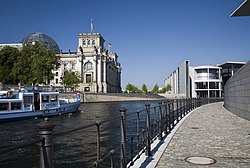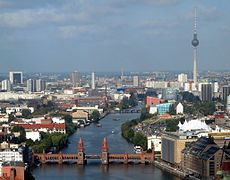geo.wikisort.org - River
The Spree (German: [ˈʃpʁeː] (![]() listen) SHPRAY; Sorbian languages: Sprjewja, Czech: Spréva) is, with a length of approximately 400 kilometres (250 mi), the main tributary of the River Havel. The Spree is much longer than the Havel, which it flows into at Berlin-Spandau; the Havel then flows into the Elbe at Havelberg. The river rises in the Lusatian Highlands, that are part of the Sudetes, in the Lusatian part of Saxony, where it has three sources: the historical one called Spreeborn in the village of Spreedorf, the water-richest one in Neugersdorf, and the highest elevated one in Eibau. The Spree then flows northwards through Upper and Lower Lusatia, where it crosses the border between Saxony and Brandenburg. After passing through Cottbus, it forms the Spree Forest, a large inland delta and biosphere reserve. It then flows through Lake Schwielochsee before entering Berlin, as Müggelspree (
listen) SHPRAY; Sorbian languages: Sprjewja, Czech: Spréva) is, with a length of approximately 400 kilometres (250 mi), the main tributary of the River Havel. The Spree is much longer than the Havel, which it flows into at Berlin-Spandau; the Havel then flows into the Elbe at Havelberg. The river rises in the Lusatian Highlands, that are part of the Sudetes, in the Lusatian part of Saxony, where it has three sources: the historical one called Spreeborn in the village of Spreedorf, the water-richest one in Neugersdorf, and the highest elevated one in Eibau. The Spree then flows northwards through Upper and Lower Lusatia, where it crosses the border between Saxony and Brandenburg. After passing through Cottbus, it forms the Spree Forest, a large inland delta and biosphere reserve. It then flows through Lake Schwielochsee before entering Berlin, as Müggelspree (![]() listen (help·info)).
listen (help·info)).
| Spree/Sprjewja/Spréva | |
|---|---|
 The Spree in Berlin, Reichstag building to the left | |
| Location | |
| Countries |
|
| Physical characteristics | |
| Source | |
| • location | Upper Lusatia |
| Mouth | |
• location | Havel |
• coordinates | 52°32′10″N 13°12′31″E |
| Length | about 400 km (250 mi) |
| Basin size | 10,105 km2 (3,902 sq mi) |
| Discharge | |
| • average | 36 m3/s (1,300 cu ft/s) |
| Basin features | |
| Progression | Havel→ Elbe→ North Sea |
The Spree is the main river of Berlin, Brandenburg, Lusatia, and the settlement area of the Sorbs, who call the River Sprjewja. For a very short distance close to its sources, the Spree constitutes, as Spréva, the border between Germany (Saxony), and the Czech Republic (Bohemia). The Spree's longest tributaries are Dahme (confluence in Berlin-Köpenick) and Schwarzer Schöps (confluence in Sprey), other well-known tributaries (since they are Berlin rivers) are Panke and Wuhle.
Course

It rises in the Lusatian Mountains and flows north through Bautzen and Spremberg.[1]
In the Spreewald the river passes through the towns of Lübbenau, Lübben and Leibsch. Just below Leibsch, the Dahme Flood Relief Canal diverts water from the Spree to run into the River Dahme at Märkisch Buchholz. The Spree continues north from Leibsch before flowing into the Neuendorfer See at the northern edge of the Spreewald. From the Neundorfer See it then flows in an easterly direction to the Schwielochsee, and then in a northerly and westerly direction to the town of Fürstenwalde. From Fürstenwalde the river continues to flow westwards, through the Dämeritzsee and Müggelsee, to Köpenick in the southeastern part of Berlin, where it is joined by its tributary, the River Dahme.[2]
The final reach of the Spree is where it is best known. It flows through the city centre of Berlin to join the River Havel in Spandau, one of Berlin's western boroughs, which itself ultimately merges with the Elbe to enter the sea in Cuxhaven, after flowing through Hamburg. On its route through Berlin, the river passes Berlin Cathedral (Berliner Dom), the Reichstag and the Schloss Charlottenburg. The renowned Museum Island (Museumsinsel), with its collection of five major museums, is an island in the Spree.[2]
In 2004 the Badeschiff floating swimming pool opened on the Spree in Berlin.[3]
Navigation
Small craft, such as punts, are widely used in wetlands of the Spreewald. Larger craft can reach as far upstream as Leibsch, although the upper reaches are relatively shallow and are generally only used by leisure craft. Some intermediate reaches are unnavigable and by-passed by canals.[2]
For a stretch of about 20 kilometres (12 mi) east of and flowing through Fürstenwalde, the river forms part of the Oder-Spree Canal. On this reach, and on the reach west of the confluence with the River Dahme at Köpenick, the river forms part of secondary commercial link between Berlin and the River Oder and hence Poland.[2] The canal diverges from the Spree just east of Fürstenwalde and later joins the River Dahme at the (lake) Seddinsee.
In Berlin, the Spree forms part of a dense network of navigable waterways, many of which are artificial, and which provide a wide choice of routes. Several important commercial harbours can be found on this network, and tugs and barges move sand, grain, bricks, and beer. Tour boats tour the central section of the Spree and its adjoining waterways on a frequent basis.[2][4]
Berlin Wall
Many people died in the Spree during the Cold War while trying to cross the Berlin Wall, including children who drowned when rescuers were not allowed to enter the river to save them.
Images
- Spree in Bautzen
- Spree north of Bautzen
- Spree in the Spreewald
- Spree with Berlin Hauptbahnhof & the entrance of a canal
- The Federal Chancellery (Berlin) on the Spree
 Bode Museum at the tip of Museum Island in the Spree
Bode Museum at the tip of Museum Island in the Spree- Spree in central Berlin, with Oberbaum Bridge
- Spree Shore in Berlin Friedrichshain
References
- "Spree River". Encyclopaedia Britannica. Retrieved 19 February 2021.
- Sheffield, Barry (1995). Inland Waterways of Germany. St Ives: Imray Laurie Norie & Wilson. pp. 113–122. ISBN 0-85288-283-1.
- James, Kyle. "A Pool with a View". Deutsche Welle. Retrieved 2010-05-15.
- Gawthrop, John; Williams, Christian (2008). The Rough Guide to Berlin. London - New York - Delhi: Rough Guides. pp. 28–29. ISBN 978-1-85828-382-1.
External links
- Panorama Spree - Panoramic view of the river in Berlin
- . Encyclopædia Britannica (11th ed.). 1911.
На других языках
[de] Spree
Die Spree (sorbisch Sprjewja, niedersorbisch auch schlicht Rěka ,Fluss‘[3]; tschechisch Spréva), in Abschnitten Große Spree genannt, ist ein knapp 400 Kilometer langer linker Nebenfluss der Havel im Osten Deutschlands, der am Oberlauf für ein kurzes Stück durch den äußersten Norden Tschechiens fließt. Da am Zusammenfluss von Spree und oberer Havel in Berlin-Spandau die Spree sowohl länger als auch wasserreicher als der Oberlauf der Havel ist, bilden hydrologisch gesehen Spree und untere Havel einen Flusslauf, und die obere Havel ist dessen Nebenfluss. Teilstrecken sind einerseits als Bundeswasserstraße, andererseits als Landeswasserstraße klassifiziert.[4]- [en] Spree (river)
[es] Spree
El Spree[2] o Esprea (en sorbio: Sprjewja; en checo: Spréva) es un río de Alemania que se comunica por medio de canales navegables con el mar Báltico y se ensancha en Berlín formando un puerto fluvial. Serpentea por buena parte de la ciudad y sirve de marco a varios de los edificios más emblemáticos. Es un afluente del Havel, afluente a su vez del Elba.[it] Sprea
La Sprea (AFI: /ˈsprɛa/; in tedesco Spree, in lingua soraba Sprjewja/Sprowja) è un fiume della Germania nord-orientale (Brandeburgo), affluente di sinistra dell'Havel.Другой контент может иметь иную лицензию. Перед использованием материалов сайта WikiSort.org внимательно изучите правила лицензирования конкретных элементов наполнения сайта.
WikiSort.org - проект по пересортировке и дополнению контента Википедии







